
Warhammer 40,000 is a miniature wargame produced by Games Workshop. It is the most popular miniature wargame in the world, and is particularly popular in the United Kingdom. The first edition of the rulebook was published in September 1987, and the ninth and current edition was released in July 2020.

Games Workshop Group is a British manufacturer of miniature wargames, based in Nottingham, England. Its best-known products are Warhammer Age of Sigmar and Warhammer 40,000.
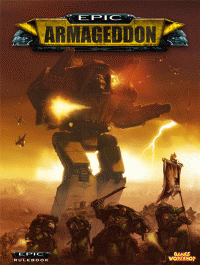
Epic is a tabletop wargame set in the fictional Warhammer 40,000 universe. Whereas Warhammer 40,000 involves small battles between forces of a few squads of troops and two or three vehicles, Epic features battles between armies consisting of dozens of tanks and hundreds of soldiers. Due to the comparatively larger size of the battles, Epic miniatures are smaller than those in Warhammer 40,000, with a typical human being represented with a 6mm high figure, as opposed to the 28mm minis used in Warhammer 40,000. Since being first released in 1988 as Adeptus Titanicus, it has gone through various editions with varying names.

WarCry is an out-of-print collectible card game set in the world of Warhammer Fantasy and published by Sabertooth Games. The base game cards were released in 2003, with newer expansions introduced in the months since. A video game adaptation, titled Warhammer: Battle for Atluma, was created for the PSP in 2006.

Warhammer 40,000: Dawn of War is a military science fiction real-time strategy video game developed by Relic Entertainment and based on Games Workshop's tabletop wargame Warhammer 40,000. It was released by THQ on September 20, 2004 in North America and on September 24 in Europe. Three expansion packs have been released: Winter Assault in 2005, Dark Crusade in 2006, and Soulstorm in 2008. Its first sequel, Dawn of War II was released in February 2009. Another sequel, Dawn of War III, was released in April 2017.
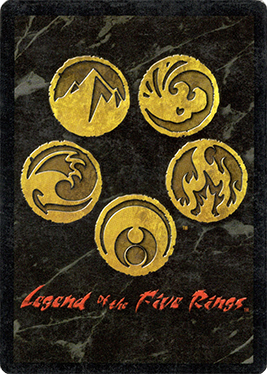
Legend of the Five Rings (L5R) is an out-of-print collectible card game created by a joint venture featuring Alderac Entertainment Group and ISOMEDIA in 1995 and published until 2015, when it was announced that the game would be discontinued for a rules-incompatible successor that will be part of Fantasy Flight Games' Living Card Game line. L5R takes place in the fictional empire of Rokugan from the Legend of the Five Rings setting, where several clans and factions vie for domination over the empire.
BL Publishing was a division of Games Workshop, and was split into three sections:
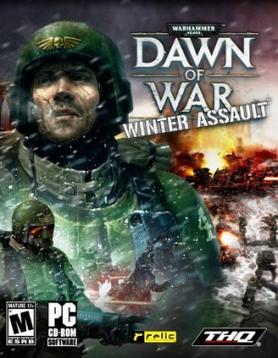
Warhammer 40,000: Dawn of War – Winter Assault is the first expansion to Warhammer 40,000: Dawn of War for the PC developed by Relic Entertainment and published by THQ. Based on Games Workshop's tabletop wargame, Warhammer 40,000, Dawn of War: Winter Assault was released on September 23, 2005. Some time after its initial release, Winter Assault and Dawn of War were coupled together in a double pack which featured some art on a fold out cover, an Ork with a flamethrower, or a group of Imperial Guard tanks lined up for attack. Though Winter Assault required the base game to play, its follow-up expansions, Dark Crusade and Soulstorm were stand-alone, not requiring the base game.

Horus Heresy is an out-of-print collectible card game originally produced in 2003 by Sabertooth Games. The game is set in the Warhammer 40,000 fictional universe developed by parent company Games Workshop. It attempts to recreate the struggle between the Loyalist forces of the Emperor of Mankind and the Traitor forces of Warmaster Horus, during the civil war known as the Horus Heresy. The game's development and sale by the publisher were discontinued in 2008, following financial difficulties at the parent company.
Aeronautica Imperialis is the name of two tabletop miniature wargames set within the Warhammer 40,000 universe. The games depict aerial warfare between different factions in the setting, either as one-off battles or as part of a larger narrative campaign. The first edition was released in January 2007 by Forge World, a division of the British gaming company Games Workshop. The second edition, a relaunch via Games Workshop, was released in August 2019 with a different ruleset and new, larger models.

Warhammer 40,000: Dawn of War – Dark Crusade is the second expansion to the real-time strategy video game Warhammer 40,000: Dawn of War developed by Relic Entertainment and published by THQ. Based on Games Workshop's tabletop wargame, Warhammer 40,000, Dark Crusade was released on October 9, 2006. The expansion features two new races, the Tau Empire and the Necrons. Including the Imperial Guard from Dawn of War's first expansion pack Winter Assault, a total of seven playable races in this expansion.

Warhammer 40,000: Dawn of War – Soulstorm is the third expansion to the real-time strategy video game Warhammer 40,000: Dawn of War, developed by Iron Lore Entertainment. Like its predecessors, Soulstorm is based on Games Workshop's tabletop wargame Warhammer 40,000, and introduces a multitude of new features to the Dawn of War series, including two new playable factions in the form of the Imperial Sisters of Battle and the Dark Eldar. It is a stand-alone game and does not need the original Dawn of War disc to run, but players must have the prior games installed and valid cd-keys in order to play as anything but the two new factions online.
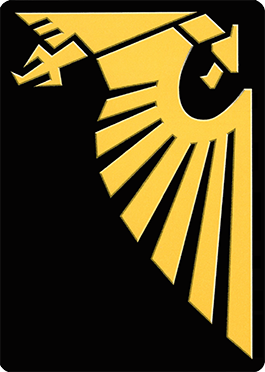
Warhammer 40,000 Collectible Card Game, sometimes denoted WH40KCCG is an out-of-print collectible card game released in 2001 by Sabertooth Games. It is set in the fictional Warhammer 40,000 universe. The players may select various factions around which they could base their personalized deck. These factions include Orks, Space Marines, Chaos, Eldar, Tyranids, Imperial Guard, and Dark Eldar; there were also sub-factions.

Warhammer 40,000: Dawn of War II – Retribution is the stand-alone second expansion to Warhammer 40,000: Dawn of War II, part of the Warhammer 40,000: Dawn of War series of real-time strategy video games. Set in Games Workshop's Warhammer 40,000 fictional universe, the single player campaign is playable with multiple races.
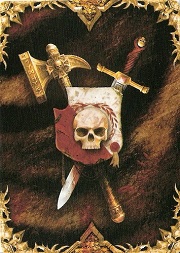
Warhammer: Invasion is a Living Card Game (LCG) designed by Eric M. Lang and produced by Fantasy Flight Games in 2009, set in the Warhammer Fantasy universe. Like Fantasy Flight's other LCGs, Invasion is sold as a core set, which can be played on its own, or built upon with expansion packs. Each pack has a fixed set of 3 copies each of 20 cards. There are six factions in Invasion: Dwarves, Empire, Orcs, Chaos, High Elves, and Dark Elves. The first four have decks in the core set, while the elves' decks are available in the Assault on Ulthuan expansion.

Warhammer 40,000: Conquest was a Living Card Game (LCG) produced by Fantasy Flight Games, set in Games Workshop's Warhammer 40,000 universe. It was announced in March 2014 and was released October 3, 2014. The game featured two players competing to win a series of battles on a different planets while simultaneously securing the resources of other planets that will have battles on subsequent turns. Fans of the game praised the strategic element of having multiple distinct battle fields as a feature that distinguished it from other card games. On September 9, 2016, Games Workshop announced that Conquest would be discontinued in February 2017, as a result of Games Workshop's failure to renew Fantasy Flight Games' contract because of a conflict between Games Workshop and Fantasy Flight Games' parent company, Asmodee. The game still has a small community of players who play with the cards that were printed before the game's discontinuation in 2017, and some fans have made unofficial expansions to expand the small card pool.

Battlefleet Gothic: Armada is a real-time tactics video game developed by Tindalos Interactive and published by Focus Home Interactive. It is set in the fictional universe of Warhammer 40,000, and is specifically an adaptation of the miniature wargame Battlefleet Gothic by Games Workshop.

Star Realms is a card-based deck building science-fiction tabletop game, designed by Rob Dougherty and Darwin Kastle and published in 2014 by Wise Wizard Games. The game started out as a Kickstarter campaign in 2013. The goal of Star Realms is to destroy opponents by purchasing cards using "trade" points and using these cards to attack an opponent's "authority" using "combat" points. The game takes place in a distant future where different races compete to gain resources, trade and outmaneuver each other in a race to become ruler of the galaxy.
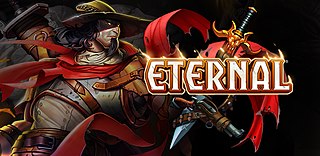
Eternal is a free-to-play online collectible card video game developed and published by Dire Wolf Digital. Eternal is available for iOS, Android, Xbox One, PCs using Steam and Nintendo Switch. The game features cross-platform play, allowing players to use any of the supported platforms to compete against each other. The game takes place in a Weird West fantasy setting. The game was in Steam early access in November 2016 and then had its official wide release in November 2018 that included support for the Xbox One. Eternal was released for the Switch on October 8, 2019.

















